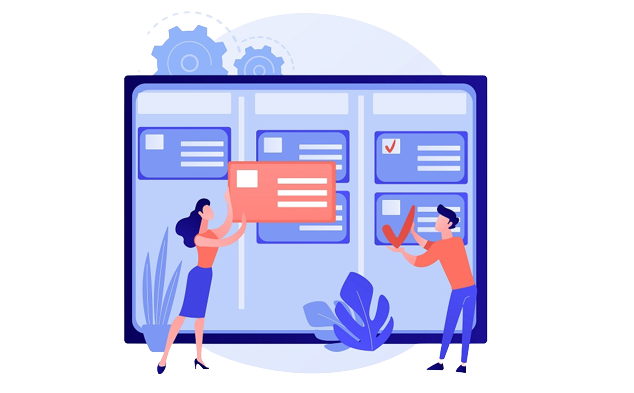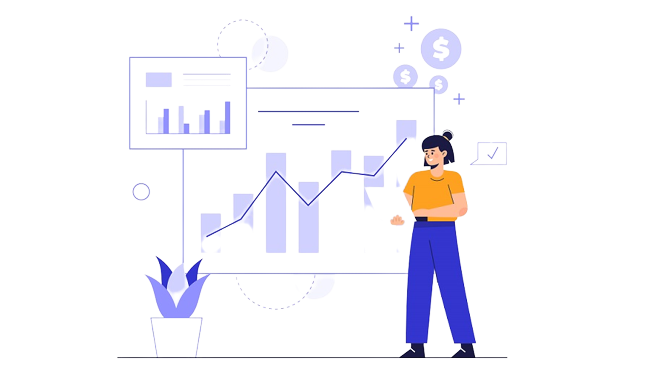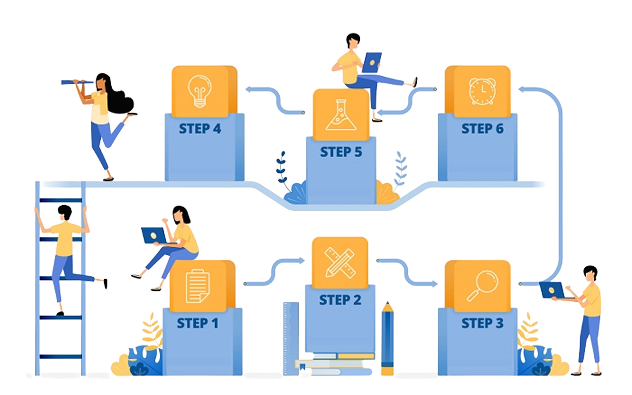
CRM is a powerful tool and has become increasingly popular as it helps businesses manage and optimize their sales process. And at the heart of effective sales management in CRM lies the sales pipeline – a dynamic framework that can truly make a difference in boosting efficiency and driving revenue.
This blog post is about understanding the fascinating world of sales pipeline CRM and exploring how they play a crucial role in the success of sales teams. We’ll uncover the key components and stages of a sales pipeline, understand why it’s so important for streamlining the sales process, and most importantly, discover the real-world benefits it brings to organizations like yours.
What Is A Sales Pipeline In CRM and Why Is It Important?
A sales pipeline is like a roadmap that guides sales teams through the entire customer acquisition journey. It helps them visualize the process from the moment a lead is generated to closing the deal. With the help of a CRM system, the sales pipeline becomes an organized and structured framework that sales teams can rely on to effectively manage their leads, nurture prospects, and ultimately turn them into loyal customers.
Think of it this way: sales pipelines are like clear lenses that bring clarity and structure to the sales process. They break down the journey into manageable stages, allowing sales representatives to easily track and monitor the progress of each opportunity. By having a visual representation of the pipeline, sales teams gain valuable insights into their current and upcoming deals, which helps them prioritize activities, allocate resources wisely, and concentrate their efforts where it truly counts.
The importance of sales pipeline software lies in its ability to provide clarity and structure to the sales process. It enables sales teams to have a clear overview of their prospects and helps them prioritize their efforts accordingly. By visualizing the different stages of the pipeline, sales representatives can better manage their time and resources, focus on high-priority opportunities, and maintain a steady flow of leads through the sales funnel. Moreover, a well-implemented sales pipeline allows for accurate sales forecasting and enables businesses to make informed decisions based on real-time data.
Key Components and Stages of A Sales Pipeline In CRM
A sales pipeline in CRM typically consists of several key components and stages that guide the sales process. While the specific stages may vary depending on the business and industry, the following are common components found in most sales pipelines:
- Lead generation: This initial stage involves identifying potential prospects and capturing their contact information through various channels, such as marketing campaigns, website forms, or referrals.
- Lead qualification: In this stage, sales representatives evaluate leads based on predefined criteria to determine their potential as viable opportunities. This step ensures that the sales team focuses their efforts on leads with the highest likelihood of converting into customers.
- Needs analysis: Once a lead qualifies as a potential opportunity, sales representatives engage in conversations with the prospect to understand their specific needs, challenges, and requirements. This stage involves active listening, asking probing questions, and conducting thorough research to gather relevant information.
- Proposal and presentation: After analyzing the prospect’s needs, sales representatives craft customized proposals and presentations that outline how their products or services can address the prospect’s pain points and deliver value. This stage often involves showcasing product demonstrations, providing case studies, and addressing any concerns or objections.
- Negotiation and closing: Once the prospect shows interest and expresses the intent to move forward, negotiations on pricing, terms, and conditions ensue. This stage requires effective communication and negotiation skills to reach mutually beneficial agreements. Finally, the deal is closed, and the prospect becomes a customer.
These stages act as stepping stones that guide sales teams through the sales process, ensuring that no opportunity slips through the cracks. By leveraging CRM software, sales representatives can easily update and track the status of each opportunity, fostering collaboration, transparency, and accountability within the team.
Benefits of Using A Sales Pipeline In CRM For Sales Teams

Implementing a sales pipeline within a CRM system offers numerous benefits to sales teams:
- Improved sales visibility: Sales pipelines provide a clear overview of all ongoing opportunities, allowing sales managers and representatives to track and monitor the progress of each deal. This visibility enables effective resource allocation, and timely follow-ups, and ensures that no opportunity falls through the cracks.
- Enhanced sales forecasting: Sales pipelines facilitate accurate sales forecasting by providing real-time data on the number of leads, conversion rates, and deal values at each stage. This enables sales teams to project future revenue, set realistic targets, and make data-driven decisions.
- Streamlined sales process: Sales pipelines help streamline the sales process by providing a structured framework and predefined stages for each opportunity. This structure ensures that sales representatives follow a consistent approach, avoid skipping essential steps, and maintain a smooth flow of leads through the pipeline.
- Improved collaboration and communication: Sales pipelines foster collaboration within the sales team and other departments by providing a shared understanding of the sales process. This promotes better communication, facilitates knowledge sharing, and ensures that everyone is aligned toward achieving the common goal of closing deals.
- Identifying bottlenecks and optimization opportunities: By visualizing the sales pipeline, sales teams can identify bottlenecks, delays, or areas for improvement in the sales process. This insight allows them to optimize their approach, refine strategies, and implement corrective measures to increase efficiency and effectiveness.
Thus, implementing a sales pipeline within a CRM system empowers businesses to manage their sales activities effectively, prioritize leads, and nurture relationships with prospects, ultimately leading to increased success and growth.
Optimizing Sales Efficiency with CRM Sales Pipelines
Optimizing Sales Efficiency with CRM Sales Pipelines involves the process of maximizing the productivity, effectiveness, and results of your sales efforts by leveraging the capabilities of CRM systems and their sales pipeline functionalities. Businesses can employ the structure and features of CRM sales pipelines to streamline and enhance various aspects of the sales process, including lead management, sales tracking, communication, collaboration, and decision-making.
Let’s find out the importance of leveraging CRM sales pipelines as a tool to enhance overall sales performance and achieve better results in terms of efficiency and revenue generation.
Strategies for streamlining and optimizing your sales process using CRM sales pipelines
When it comes to streamlining your sales process, CRM sales pipelines are your secret weapon. Here are a few strategies to help you make the most of them:
- Define clear stages: Start by breaking down your sales process into clear and well-defined stages within your CRM sales pipeline. This will provide a structured framework for your sales team to follow and ensure consistency across all opportunities.
- Set measurable goals: Establish specific, measurable, and attainable goals for each stage of your CRM sales pipeline. This will help your team stay focused, track progress, and identify areas for improvement.
- Regularly review and optimize: Take the time to regularly review and analyze your CRM sales pipeline. Look for bottlenecks, delays, or inefficiencies in the process. Make adjustments and optimizations as necessary to keep your sales efforts running smoothly.
How to effectively manage and prioritize leads within a CRM sales pipeline?
Managing and prioritizing leads within your CRM sales pipeline is essential for maximizing your sales efficiency. Here are a few tips to help you effectively manage and prioritize leads:
- Implement lead scoring: Develop a lead scoring system within your CRM to assess the quality and potential of each lead. Assign scores based on factors such as demographics, engagement level, and buying signals. This will help you prioritize leads and focus your efforts on those with the highest likelihood of conversion.
- Segment your leads: Divide your leads into different segments based on characteristics such as industry, company size, or geographic location. This segmentation allows you to tailor your messaging and approach to each segment, increasing your chances of success.
- Use CRM analytics: Leverage the CRM analytics capabilities to gain insights into lead behavior, conversion rates, and sales trends. This data will enable you to make data-driven decisions, identify areas of improvement, and refine your lead management strategies.
Utilizing automation and integration to enhance sales efficiency in CRM sales pipelines

Automation and integration are game-changers when it comes to boosting sales efficiency. Here’s how you can leverage them within your CRM sales pipelines:
- Automate repetitive tasks: Identify repetitive and time-consuming tasks within your sales process, such as data entry or follow-up emails. Automate these tasks using your CRM’s automation features, freeing up valuable time for your sales team to focus on building relationships and closing deals.
- Integrate with other tools: Integrate your CRM system with other essential tools such as email marketing platforms, customer support software, or accounting systems. This integration allows for seamless data flow, eliminates manual data entry, and provides a holistic view of your customer interactions.
- Implement sales process workflows: Create predefined workflows within your CRM that guide your sales team through each stage of the sales process. These workflows can automate tasks, prompt follow-ups, and ensure that nothing falls through the cracks.
By implementing these strategies, effectively managing and prioritizing leads, and harnessing the power of automation and integration, you can supercharge your sales efficiency within CRM sales pipelines.
Increasing Revenue through Effective CRM Sales Pipelines
Increasing revenue through effective CRM sales pipelines involves leveraging the power of CRM systems to identify and seize sales opportunities, accurately forecasting revenue through data analysis, and measuring pipeline metrics for performance improvement. CRM sales pipelines provide a structured framework that enables organizations to streamline their sales efforts, prioritize high-value opportunities, and ultimately boost their revenue generation.
Leveraging CRM sales pipelines to identify and capitalize on sales opportunities
One of the key benefits of utilizing CRM sales pipelines is their ability to help businesses identify and capitalize on sales opportunities. By effectively managing and tracking leads through the pipeline, sales teams can pinpoint potential deals, prioritize their efforts, and focus on the most promising opportunities.
Within a CRM system, each stage of the sales pipeline represents a distinct phase of the customer acquisition process. As leads progress through these stages, sales representatives can gather valuable information and insights about their needs, preferences, and buying behaviors. This data can then be used to tailor sales strategies, create personalized offers, and address specific pain points, increasing the chances of closing the deal successfully.
CRM sales pipelines also enable sales teams to track customer interactions, such as email communications, meetings, or phone calls, allowing them to build stronger relationships and provide timely and relevant follow-ups. By leveraging these insights, sales representatives can nurture leads effectively, address objections, and ultimately convert prospects into loyal customers, leading to increased revenue generation.
Techniques for accurate forecasting and projecting revenue using CRM sales pipelines

Accurate revenue forecasting is crucial for organizations to plan their resources, set targets, and make informed business decisions. CRM sales pipelines provide a solid foundation for generating accurate revenue forecasts by capturing and organizing essential data points throughout the sales process.
To enhance revenue forecasting accuracy, sales teams can implement the following techniques:
- Historical analysis: Analyze past sales data and trends within the CRM sales pipeline to identify patterns and understand historical conversion rates at each stage. This analysis provides a benchmark for forecasting future revenue based on the progress of opportunities through the pipeline.
- Probability-based forecasting: Assign probabilities to each opportunity based on its stage within the CRM sales pipeline. These probabilities can be determined by analyzing historical data or through the use of predictive analytics. By multiplying the probability by the potential deal value, sales teams can estimate the expected revenue for each opportunity and aggregate them for an accurate revenue projection.
- Regular pipeline reviews: Conduct regular reviews of the CRM sales pipeline to evaluate the health and progress of opportunities. Identify any bottlenecks, stalled deals, or potential risks that may impact revenue generation. Adjust forecasts accordingly based on the insights gained from the pipeline review process.
Measuring and analyzing sales pipeline metrics for revenue growth and performance improvement
Measuring and analyzing sales pipeline metrics is vital for monitoring performance, identifying areas of improvement, and driving revenue growth. CRM systems provide a wealth of data and metrics that can be leveraged to gain valuable insights into the sales pipeline’s health and effectiveness.
Some key sales pipeline metrics to consider include:
- Conversion rates: Measure the percentage of leads that successfully move through each stage of the CRM sales pipeline. Analyze conversion rates at different stages to identify potential bottlenecks and areas for improvement.
- Sales cycle length: Calculate the average time it takes for opportunities to progress through the sales pipeline from lead generation to deal closure. Identifying and reducing bottlenecks in the sales cycle can lead to shorter sales cycles and accelerated revenue generation.
- Win rate: Measure the percentage of opportunities that result in successful deal closure. Monitoring win rates can help sales teams identify strengths, weaknesses, and areas for improvement in their sales process, enabling them to optimize their approach and increase revenue.
- Sales velocity: Assess the speed at which opportunities move through the sales pipeline. By tracking the time it takes for leads to progress from one stage to another, sales teams can identify ways to streamline their processes, prioritize high-value opportunities, and increase revenue velocity.
By regularly measuring and analyzing these sales pipeline metrics, organizations can gain valuable insights into their sales performance, identify areas for improvement, and make data-driven decisions to optimize their sales processes for revenue growth.
Steps To Successfully Implement CRM Sales Pipelines In Your Sales Process

Implementing free CRM for sales pipelines can greatly enhance the effectiveness and efficiency of your sales process. To ensure a successful implementation, follow these key steps:
Step 1 – Define your sales process. Start by clearly defining your sales process and understanding the specific stages involved. Identify the key actions and milestones that lead to successful deal closures. This clarity will serve as the foundation for structuring your CRM sales pipelines.
Step 2 – Customize CRM to fit your sales process. Configure your CRM system to align with your defined sales process. Customize the pipeline stages, naming conventions, and any additional fields or attributes that are specific to your business. This customization will ensure that your CRM accurately reflects your unique sales journey.
Step 3 – Set up lead capture and data integration. Establish mechanisms to capture leads directly into your CRM system. This can be done through web forms, lead generation tools, or integration with other marketing platforms. Ensure a seamless flow of data from lead capture to the CRM sales pipeline, minimizing manual entry and reducing the risk of data errors.
Step 4 – Standardize data entry and update practices. Define clear guidelines and standards for data entry and updates within the CRM sales pipelines. This ensures consistency and accuracy in recording lead information, activities, and stage progress. Encourage your sales team to regularly update and maintain the pipeline data to keep it reliable and up to date.
Step 5 – Monitor and analyze pipeline metrics. Regularly review and analyze the metrics associated with your CRM sales pipelines. Track conversion rates, sales velocity, and other relevant performance indicators. Use these insights to identify areas for improvement, optimize your sales strategies, and drive revenue growth.
Step 6 – Continuously refine and improve. CRM sales pipelines are not set in stone. Continuously evaluate and refine your sales process based on real-world data and feedback. Adapt your pipelines as your business evolves, incorporating feedback from your sales team and adjusting stages, fields, or workflows to better align with your evolving needs.
Step 7 – Foster collaboration and communication. Encourage collaboration and communication within your sales team through the CRM system. Facilitate the sharing of information, updates, and insights related to leads and opportunities. This promotes teamwork, enhances visibility, and ensures everyone is aligned on the progress and status of each opportunity.
By following these steps, you can successfully implement CRM sales pipelines into your sales process. With an organized and streamlined approach, you can effectively manage leads, track progress, and drive revenue growth through optimized sales strategies and improved decision-making.
Key Takeaways!
The role of sales pipelines in CRM is instrumental in boosting efficiency and driving revenue growth for organizations. By implementing a well-structured sales pipeline within a CRM system, businesses can streamline their sales process, effectively manage leads, and prioritize high-value opportunities.
The sales pipeline provides a visual representation of the customer journey, allowing sales teams to track progress, identify bottlenecks, and make data-driven decisions.
With the ability to forecast revenue, measure performance, and optimize sales strategies, CRM sales pipelines empower organizations to increase efficiency, enhance productivity, and ultimately achieve higher revenue generation. By harnessing the power of CRM sales pipelines, businesses can thrive in today’s competitive market and achieve long-term success.